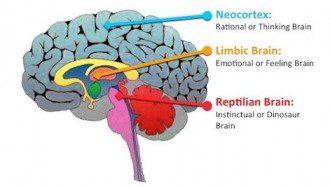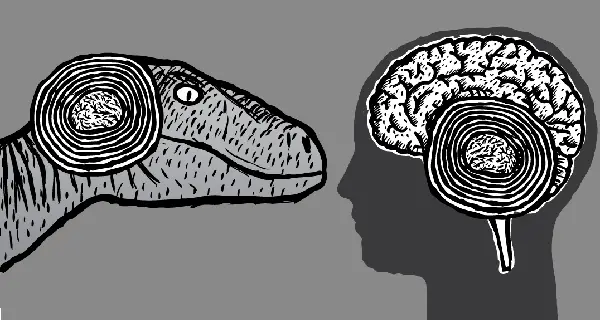18th May 2016
Contributing writer for Wake Up World
We’ve all had those kinds of days where everything seems to go wrong. You’re running late, and hit every single stoplight from home to work. Kids are uncooperative. You forget your phone (and wallet). You spill coffee down the front your shirt. And so it goes. Nothing overly shocking, it happens to everyone now and again, but science is finding that how we respond to these kinds of challenging circumstances says a lot about how our brains are wired — and how resilient (and happy) we are when faced with negative events.
The amygdala (or “fear” center of the brain) generally gets a bad rap, known to be responsible for depression, anxiety and aggression — those very emotions that can be triggered when we’re having a tough day. It’s the oldest part of the brain and considered the most primitive, continually on the lookout for potential dangers. The small, almond-shaped brain region is associated with negative stimuli, and it’s largely accepted that those who have elevated activity in this area are prone to heightened levels of negative emotions. However, new research has discovered that the amygdala also responds to positive stimuli — and is strongly associated with compassion, human connection and happiness.
According to Greater Good, “the happiest people don’t ignore threats. They just might be better at seeing the good.”
Not your average Pollyanna
It’s generally agreed that people with sunnier dispositions are apt to weather the bumps and bruises of life much easier than those who have pessimistic mental states. There’s a certain resiliency that positive people seem to possess, but does it simply come down to ignoring the negatives and viewing life through the proverbial “rose colored glasses”? Or becoming a Pollyanna positivity fanatic? What’s their secret to skillfully navigating life’s ups and downs with the highest happiness quotient possible? These questions are important because they have far-reaching implications for how you view your own life — and the subsequent joy and happiness you are able to experience over the long-term.
Surprising function of the evolutionary brain
Psychologist William Cunningham of the University of Toronto published groundbreaking work in the Journal of Cognitive Neuroscience demonstrating that the amygdala’s role goes far beyond simply keeping us safe from what we perceive as threats.
Cunningham and his colleagues showed a series of side-by-side pictures to study participants while documenting their amygdala activity using functional magnetic resonance imaging (fMRI). The images spanned a range of emotional content — positive, negative or neutral.
As expected, the negative pictures triggered amygdala activity. However, the positive images did as well — but only when participants were told to concentrate on them. As a rule, humans tend to focus on threats or negative stimuli. But this research shows that people can compensate for it by purposely focusing more on the positive. “While people do automatically attend to negative stimuli, given the proper ability and motivation, they can show the same sensitivity to positive stimuli,” said the research team.
Cunningham was involved in another study that found the amygdala “may also be at the heart of compassion.” The researchers scanned participants’ brains while they viewed pictures of people that were either in need of help or who might be useful in pursuing a goal. The data clearly indicated amygdala activity spiked when participants observed people in need, which was particularly true for those who scored high in empathy.
The research team noted that other studies have associated the ability to connect with and help others also fosters personal well-being. Apparently, humans have a “compassionate instinct” — a strong desire to help people that is located in the part of the brain which is oftentimes associated only with “primitive” or “reptilian” emotional states. The paper concludes:
“This research project builds on the idea that our evolutionarily older brain systems are not solely a source of immorality and selfishness, but when tuned by our goals, can contribute to moral and just behavior. Thus, human flourishing does not come from the suppression of aspects of the self, but rather through the integration of all relevant processes together into a unified response.” [source]
The question is: how does the activation of the amygdala of a happy person compare to someone who leans more toward a gloomy disposition? That’s exactly what Cunningham and Ph.D. student Tabitha Kirkland addressed in a subsequent study published in the journal Social Cognitive and Affective Neuroscience.
Taking the good with the bad
The team documented amygdala activity of 42 participants while they viewed a range of positive, negative and neutral pictures. Additionally, the participants completed surveys to establish their subjective happiness levels.
After the data was collected and analyzed, Cunningham and Kirkland discovered that happier people had greater amygdala activation in relation to the positive images. What was surprising, however, is that these same people did not have a decreased response to negative images — effectively ruling out the “rose-colored glasses” viewpoint of happiness. As a matter of fact, they found that “amygdala activation among happier participants was equally high for positive and negative stimuli.” The findings suggest that “happier people are not necessarily naïve or blind to negativity, but rather may respond adaptively to the world, recognizing both good and bad things in life.”
The takeaway message of this research is that our amygdala’s role isn’t just as the brain’s fear center, but actually assists us — on a very instinctual level — to see people in need and respond in a helpful manner. This in turn can cultivate connection and happiness in our own lives.
Article sources
- http://scan.oxfordjournals.org/content/early/2013/05/17/scan.nst045.full
- http://greatergood.berkeley.edu/article/item/how_happy_brains_respond_to_negative_things
- http://www.ncbi.nlm.nih.gov/pubmed/25390201
- http://socialneuro.psych.utoronto.ca/Chapter_7.pdf
- http://www.huffingtonpost.com/2012/04/11/happiness-and-hardships_n_1417944.html
- http://greatergood.berkeley.edu/article/item/5_ways_giving_is_good_for_you
About the author:
 Carolanne Wright enthusiastically believes if we want to see change in the world, we need to be the change. As a nutritionist, natural foods chef and wellness coach, Carolanne has encouraged others to embrace a healthy lifestyle of organic living, gratefulness and joyful orientation for over 13 years.
Carolanne Wright enthusiastically believes if we want to see change in the world, we need to be the change. As a nutritionist, natural foods chef and wellness coach, Carolanne has encouraged others to embrace a healthy lifestyle of organic living, gratefulness and joyful orientation for over 13 years.
Through her website Thrive-Living.net, she looks forward to connecting with other like-minded people from around the world who share a similar vision. You can also follow Carolanne on Facebook, Twitter and Pinterest.
Further reading from Carolanne Wright:
- The Most Eco-Friendly Nation on the Planet is Now Carbon Negative
- Don’t Ask, Just Plant — Taking Back Our Food Sovereignty with Guerrilla Gardening
- Plastic Waste in the Ocean Will Outnumber Fish by 2050
- Seed Bombs: A Creative (and Fun) Mission to Save the Bees and Butterflies
- Mind Control, Subliminal Messages and the Brainwashing of America
- Autistic Boy with Higher IQ Than Einstein Discovers Gift After Removal from State-Run Therapy
- Monsanto Charged with Crimes Against Nature and Humanity – Set to Stand Trial in 2016
- Dr Sebi: The Man Who Cures Aids, Cancer, Diabetes and More
- Plastic-Eating Mushroom Discovered in the Amazon Rainforest — A Solution for Our Trash Saturated World?
- Big Pharma and Organized Crime — They are More Similar Than You May Think
- Over 100 Scientific Studies Agree: Cannabis Annihilates Cancer
- Emotional Energetic Healing: The Future of Medicine is Here
- Why Every Parent Should Consider Unschooling
- The Greenhouse of the Future: Grow Your Own Food Year-Round With This Revolutionary System
- First U.S. City Produces More Electricity Than It Uses — With 100% Renewable Technology
Source Article from http://wakeup-world.com/2016/05/18/scientists-discover-instinctual-reptilian-region-of-the-brain-directly-linked-to-compassion-happiness/
 RSS Feed
RSS Feed















 May 17th, 2016
May 17th, 2016  Awake Goy
Awake Goy 

 Posted in
Posted in  Tags:
Tags: 













